AMD Reveals Threadripper 2 : Up to 32 Cores, 250W, X399 Refresh
by Ian Cutress on June 5, 2018 11:05 PM EST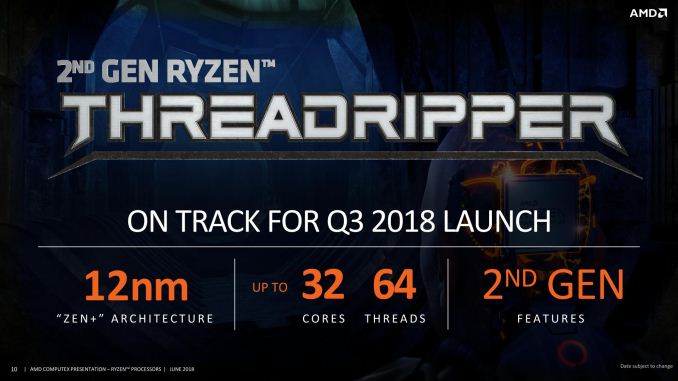
One of the surprises from AMD’s first year of the newest x86 Zen architecture was the launch of the Threadripper platform. Despite the mainstream Ryzen processors already taking a devastating stab into the high-end desktop market, AMD’s Threadripper offered more cores at a workstation-friendly price. For 2018, the next generation is going to be using AMD’s updated 12nm Zeppelin dies, as well as including a few new tweaks into the system including better boost and faster caches.
This article is still a work in progress, and will be updated as more news comes in.
AMD’s Zeppelin silicon has 8 cores, and the first generation Threadripper uses two of them to get to the top-SKU of 16-cores. Inside the CPU however, there are four pieces of silicon: two active and two inactive. For this second generation of Threadripper, called Threadripper 2 or the Threadripper 2000-series, AMD is going to make these inactive dies into active ones, and substantially increase the core count for the high-end desktop and workstation user.
At the AMD press event at Computex, it was revealed that these new processors would have up to 32 cores in total, mirroring the 32-core versions of EPYC. On EPYC, those processors have four active dies, with eight active cores on each die (four for each CCX). On EPYC however, there are eight memory channels, and AMD’s X399 platform only has support for four channels. For the first generation this meant that each of the two active die would have two memory channels attached – in the second generation Threadripper this is still the case: the two now ‘active’ parts of the chip do not have direct memory access.
This technically adds latency to the platform, however AMD is of the impression that for all but the most memory bound tasks, this should not be an issue (usually it is suggested to just go buy an EPYC for those workloads). While it does put more pressure on the internal Infinity Fabric, AMD ultimately designed Infinity Fabric for scalable scenarios like this between different silicon with different levels of cache and memory access.
Update: AMD has just published a full copy of their slide deck for the Threadripper 2 presentation. In it are a few interesting factoids.
| AMD Threadripper CPUs | |||||
| Threadripper 2 32-Core Sample |
Threadripper 2 24-Core Sample |
Threadripper 1950X |
Threadripper 1920X |
||
| Socket | TR4 (LGA) 4094-pin |
||||
| CPU Architecture | Zen+ | Zen+ | Zen | Zen | |
| Cores/Threads | 32 / 64 | 24 / 48 | 16 / 32 | 12 / 24 | |
| Base Frequency | 3.0 GHz | 3.0 GHz | 3.4 GHz | 3.5 GHz | |
| Turbo Frequency | 3.4 GHz (WIP) | 3.4 GHz (WIP) | 4.0 GHz | 4.0 GHz | |
| L3 Cache | 64 MB ? | 48 MB ? | 32 MB | 32 MB | |
| TDP | 250W | 250W | 180W | 180W | |
| PCIe 3.0 Lanes | 60 + 4 | ||||
| Chipset Support | X399 | ||||
| Memory Channels | 4 | ||||
- Both the 24-core and 32-core sample CPUs are clocked at 3.0GHz base and 3.4GHz all-core turbo, with the latter being a work-in-progress according to the company.
- The 32-core system was equipped with DDR4-3200 memory. This is notable because the Ryzen processors based on the same 12nm Zeppelin dies officially max out at DDR4-2933.
- The codename for the processor family is listed as "Colfax". This is the first we've heard this codename from AMD.
- Despite the high TDP, both CPUs used in AMD's demos were air-cooled, using AMD's Wraith Ripper Air Cooler
Also announced at the presentation is the state of play of motherboards. According to the motherboard vendors These new Threadripper 2000-series processors will have a peak TDP rating of 250W, which is much higher than 180W we saw on the 1950X. We have been told by partners that the 250W rating is actually conservative, and users should expect lower power consumption in most scenarios. Nonetheless, it was stated by several motherboard vendors that some of the current X399 motherboards on the market might struggle with power delivery to the new parts, and so we are likely to see a motherboard refresh. That is not saying that the current X399 offerings will not work, however they might not offer overclocking to the level that users might expect. At Computex there are new X399 refresh motherboards being demonstrated by a few companies, and we will report on them in due course. Other specifications are expected to match the previous generation, such as PCIe lane counts, despite the newly active dies.
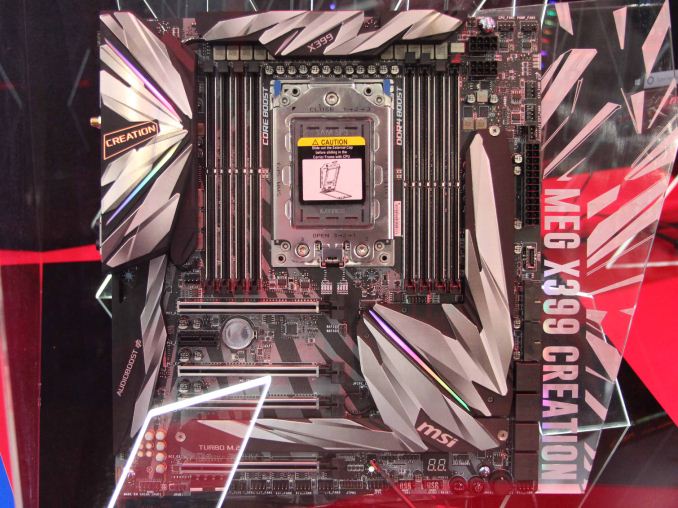
MSI's 19-phase X399 Refresh Motherboard
The launch for these new processors, according to our moles is in early August. This aligns with what AMD stated at the beginning of the year at CES, and is almost a year from the original Threadripper launch.
Pricing on the processors is set to be revealed either today or closer to the launch time. We will update this piece as more information comes in.
It will be interesting if AMD is going to go through the ‘unboxing’ embargo this time around, or just jump straight to full performance reviews. As always, come to AnandTech for the full story.
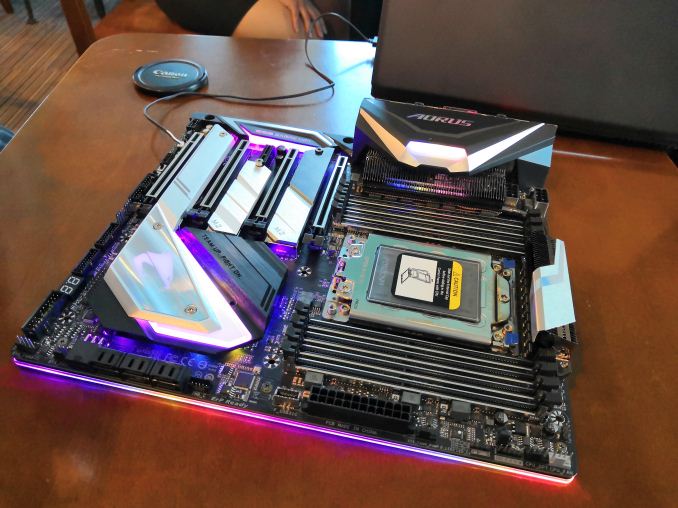
GIGABYTE's new X399 Refresh Motherboard
| Want to keep up to date with all of our Computex 2018 Coverage? | ||||||
 Laptops |
 Hardware |
 Chips |
||||
| Follow AnandTech's breaking news here! | ||||||


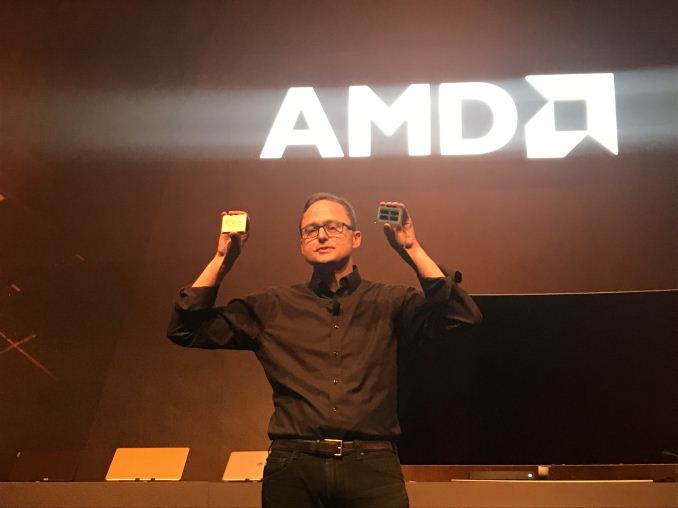
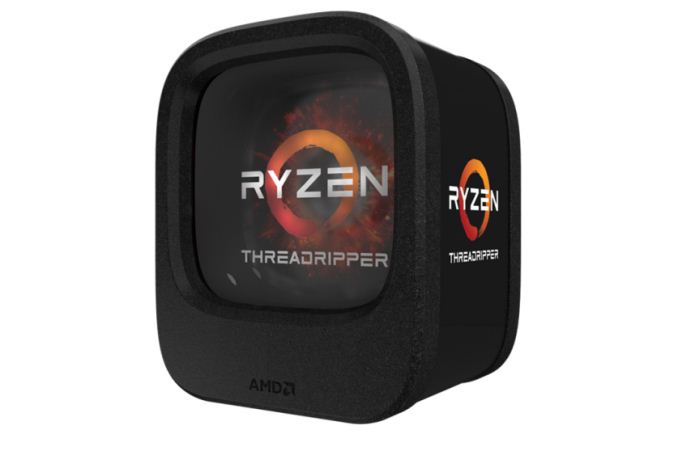
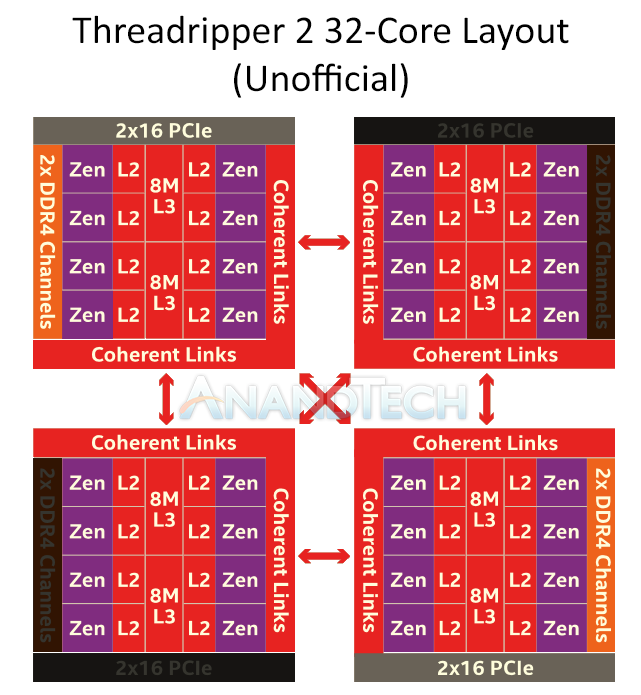
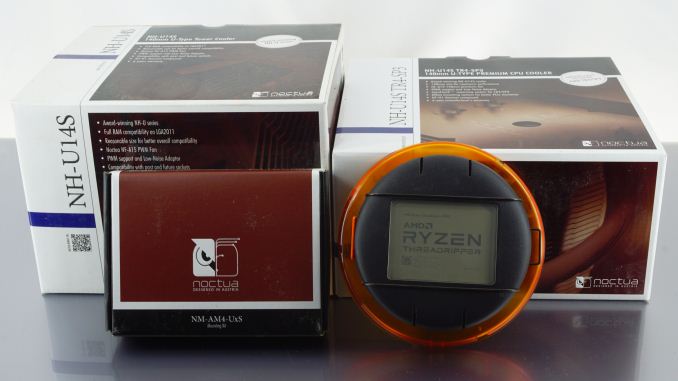














203 Comments
View All Comments
peevee - Wednesday, June 6, 2018 - link
If only they would take full advantage of 12nm in Zen+, they could have had 6 cores per CCX, 12 per die. Then Ryzen would be plenty.peevee - Wednesday, June 6, 2018 - link
I mean, without all that slow and power-hungry die-hopping.Hul8 - Wednesday, June 6, 2018 - link
If they went that route, they'd have had to create a whole new design, which would have pushed the release of Zen+ back so far, they'd have been better off just concentrating on Zen 2 on 7 nm.Targon - Thursday, June 7, 2018 - link
The problem with more cores per CCX is that in the early development phase, you would end up with more failed dies that would be garbage. 14nm was still new to Global Foundries when Ryzen first launched, so 4 cores was good for yields. Second generation could have gone to six, but due to this being a refresh cycle, why risk problems with production?7nm and Zen 2 cores MAY be the right time to go to 6-cores per CCX, but a lot depends on things like clock speed. We may see six core CCX with Zen 2, but if that will be compatible with first generation motherboards, or if there will be limitations on performance due to changes is another story. Quad core CCX on the other hand, wouldn't be a change for the first generation motherboards, and only clock speed plus other things such as power would come into play.
Windows and how Windows talks to the chipset/processor would also be another potential issue with the change to 6 core per CCX.
Dragonstongue - Wednesday, June 6, 2018 - link
I honestly wish they would throw TDP in the garbage where it belongs, it is far to obscure a number because everyone who uses it seems to "calibrate" it the way THEY see fit, is a very flat number for an anything but flat comparison between products because of the numerous ways it can be tested for this number to be "hit"that is, the cpu is that 100% load on all cores, 1 core at 100% 85% of the time, 80% load all cores 60% of the time etc.
or in the case of coolers, are they testing it via a very specific "hot plate" so they supply X amount of "heat" and it keeps this cooler at Y temperature for Z amount of time etc.
They probably (IMO) should be really fine tuning the testing methods so the consumer as well as the AIB/OEM know for sure that a given cooler will work, or that you have enough power supply to power it and so forth.
nothing like a cooler made by CM H**er 2*2 being rated for 180w and when you try to strap it to a cpu that is also rated for this level that the cooler CANNOT actually deal with this heatload.
TDP is a "place holder" number as far as I can tell, AMD is generally the most conservative IMO with their TDP rating, however, all it takes is a different driver etc and this TDP number can be blown way past, so to use TDP in relation to power consumption (as so many review sites do to congratulate one part while demonizing another) is crazy.
There are VERY rare exceptions where some makers put fancy circuits into the product to make 10000000% sure it CANNOT pass this number, but these really are rare occurrence by and large in my personal experience as well as many many years of following cpu-gpu-motherboard information.
either way 250w TDP may seem like A LOT, but that is only 7.1825w per core given heat load, or 0.256 per thread, which is peanuts given the work is likely is capable of.
Intel and Nv chase the crazy high clock speeds (also make sure reviewers use VERY specific test software so that their actual absolute and continual power consumption numbers always look AMAZING) AMD on the other hand seem to be more about "yep we chew power, but, we have the performance, durability and forward looking designs they do not seem to care about"
in other words (IMHO) AMD seems to be looking at the "what will be" whereas Intel and especially Ngreedia are absolutely content about building for the moment and should is die horrible death (poor component/thermal interface choices) that is ok, means more $$$ and they will fix the problems with the next revision "we promise" ^.^
0ldman79 - Wednesday, June 6, 2018 - link
I think your math is off a bit, but your point is valid.That is, more or less, the basis for the turbo modes. 65w / 4 cores = 16.25w, but a single core can pull upwards of 30w under full load.
Given full capacity under full load with no throttling the typical 65w quad core should be 120w, which is probably what most overclockers actually see.
Da W - Thursday, June 7, 2018 - link
WHY DID I JUST BOUGHT 1000 AMD SHARES??????????FreckledTrout - Thursday, June 7, 2018 - link
Why you are screaming in broken english about the stock market on a tech site? Are you ok, you seem lost? Can we point you in the right direction?Targon - Thursday, June 7, 2018 - link
Because AMD is a company that has always been forced to be innovative, rather than using a brute force approach to getting higher performance with each new product cycle. Most people still have not heard about Gen-Z, which AMD has been a part of from the beginning for example. Looking forward, AMD is looking to improve the overall system design, not just the CPU, GPU, or chipset.Lolimaster - Thursday, June 7, 2018 - link
For any serious work you won't have this chips OCd so it should be safe for your current X399 mobos, TR3 at 7nm would be way more efficient and probably aim to 3.4-3.6Ghz base at the same TDP.